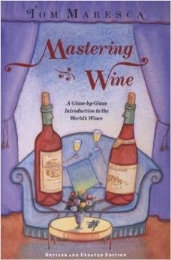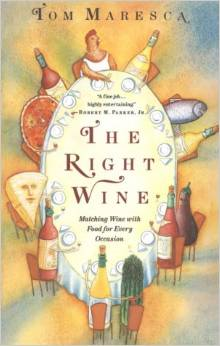On the day of our heaviest snowstorm so far this year, the annual New York presentation and tasting of Tre Bicchieri award-winning wines took place just about half a mile from where I live.
So I slogged through the flying snow and the street-corner slush to take advantage of what I hoped would be a sparse crowd and a lot of idle winemakers, thus allowing me to actually taste some wines. For the first hour, I was right, and I did have the opportunity to taste some remarkable wines – but then the storm let up and the hordes came in, and my chances for thoughtful tasting ended. I’m happy for all those hard-working winemakers that the Tre Bicchieri tasting is such a popular event, but as a hard-working journalist I do most seriously wish there was some better way to experience and evaluate these wines.
But you’ve heard that lament from me before, and are probably quite tired of it now. Besides, the key thing about this particular tasting is how many top-flight Italian wines it gathers in one room, and I don’t want to let the circumstances of the tasting obscure that. My palate and the collective palate of the Tre Bicchieri judges don’t always agree 100%, but those guys sure get an awful lot right, so a collection of almost 200 top-ranked wines amounts to an event to pay serious attention to, no matter how many people you have to elbow aside to do it.
Not that even under the best circumstances I could manage to taste all 200 in one afternoon, but I did my best to get to a reasonable assortment of old-favorite, regular prize winners and some of the new kids on the block. I was impressed by everything I tasted, without exception. I don’t get the chance to say that often, so let me repeat it: Every single wine I tasted that snowy afternoon deserved its Tre Bicchieri designation. Here are the ones I tried: first reds, then whites.
.
From Basilicata
Re Manfredi’s Aglianico del Vulture Manfredi 2013, a wonderful example of a grape I love
From Piedmont
Elvio Cogno’s Barolo Bricco Pernice 2011, another masterpiece from winemaker Valter Fissore
Bruno Giacosa’s Barbaresco Asili Riserva 2011, one of Barbaresco’s finest crus, beautifully rendered
Elio Grasso’s Barolo Ginestra Casa Maté 2012, benchmark Barolo, as always from this estate
Giacomo Fenocchio’s Barolo Bussia 90 Dì Riserva 2010, macerated 90 days on the skins, with consequent depth and intensity
Oddero’s Barolo Bussia Vigneto Mondoca Riserva 2010, a classic Barolo of a great vintage
Vietti’s Barolo Ravera 2012, a lovely, beautifully balanced wine with potentially great longevity (and I also liked Vietti’s very nice but not prize-winning Barbera d’Asti La Crena 2013)
From Sicily
Palari’s Faro Palari 2012, year after year the best red wine made in Sicily, in my opinion (and the 2012 Rosso del Soprano is right on its tail in quality: It got Due Bicchieri)
Planeta’s Cerasuolo di Vittoria Classico Dorilli 2014, a lovely light-bodied wine, refreshing and vigorous
From Tuscany
Boscarelli’s Vino Nobile di Montepulciano Il Nocio 2012, as always an elegant, complex wine
Castellare di Castellina’s I Sodi di San Niccolò 2012, graceful and lovely Sangiovese from winemaker Alessandro Cellai
Castello di Volpaia’s Chianti Classico Riserva 2013, medium-bodied, perfectly balanced, with the elegance that always marks Volpaia
Il Marroneto’s Brunello Madonna delle Grazie 2011, as always from this remarkable cru and maker, a very great wine
Mastroianni’s Brunello Vigneto Schiena d’Asino 2010, maybe the best Tuscan wine at this gathering of greats
Ricasoli’s Chianti Classico Gran Selezione Colledilà 2013, a luscious, juicy wine that drinks far too easily
Terenzi’s Morellino di Scansano Madrechiesa Riserva 2013, very young Sangiovese, with this maker’s trademark balance and elegance
From the Veneto
Allegrini’s Amarone 2012, already big and textured
Bertani’s Amarone 2008 and 2009, both still young and evolving, with great depth and the promise of decades of life
Masi’s Amarone Vaio Armaron Serègo Alighieri 2011, a stunning wine from a great site
Speri’s Amarone Vigneto Monte Sant’ Urbano 2012, another fine example of what seems to be a great year for Amarone
Tenuta Sant’Antonio’s Amarone Campo dei Gigli 2012, an infant Hercules
.
I doubt anyone is surprised by the fact that Italy is producing so many fine red wines, but for me the best news of the day was how superior so many white wines showed themselves to be. Every single one I tasted had distinct varietal flavors joined to genuine goût de terroir. This for me was the most fun of the afternoon, and I kept switching from big reds to whites of every kind to keep my palate fresh. (It worked for a couple of hours, then I gave out.)
.
From Alto Adige
Abbazia di Novacella’s Valle Isarco Sylvaner Praepositus 2015, a stunning, fresh, and vigorous wine from a grape of usually no great distinction, this year slightly better than the Abbazia’s normally superb Kerner Praepositus
Produttori San Michele Appiano’s Pinot Grigio St. Valentin 2014, high-altitude, rounder than usual PG – a real dinner wine
Produttori Valle Isarco’s Sylvaner Aristos 2015 – this seems to have been Sylvaner’s year; a lovely, lively wine
From Campania
Marisa Cuomo’s Costa d’Amalfi Furore Bianco 2015, a lovely, fragrant dinner wine coaxed from postage stamp-sized terraced vineyards along the steep Amalfi coast
Fontanavecchia’s Falanghina del Sannio Taburno 2015, lovely, characteristic Falanghina, invigorating and lively
Pietracupa’s Greco di Tufo 2015, medium-bodied and deeply flavored, with strong mineral accents, a fine wine, almost as good, in my opinion, as the same maker’s Fiano di Avellino, which didn’t get Tre Bicchieri
From Friuli Venezia Giulia
Livio Felluga’s Bianco Illivio 2014, a masterful blend of Pinot bianco, Chardonnay, and the native Picolit, sapid and intriguing
Primosic’s Collio Ribolla Gialla di Oslavia Riserva 2012, one of the briefly fashionable orange wines, but better than simple fashion: intense, distinctive, rich, and with the right food incomparable
Russiz Superiore’s Collio Friulano 2015, a lovely medium-bodied, deeply flavored (hints of almond) example of Friuli’s native grape
Torre Rosazza’s Pinot Grigio 2015, what PG used to be, fresh, vigorous, almost rambunctious
From Lazio
Casale del Giglio’s Antium Bellone 2015, distinctive, flavorful wine from an almost disappeared variety that merits preservation (Charles Scicolone has written about this estate here)
From the Marches
Cocci Grifoni’s Offida Pecorino Guido Cocci Grifoni 2013, a lovely wine from a variety that had been in danger of disappearing
Velenosi’s Offida Pecorino Rêve 2014, another fine example of the same grape variety, medium-bodied and mouth-filling; very enjoyable
From Sardinia
Vigne Surrau’s Vermentino di Gallura Superiore Sciala 2015, textbook Vermentino, fresh and bracing
From Sicily
Cusumano’s Etna Bianca Alta Mora 2014, capturing beautifully the volcanic nuances of Etna’s slopes
Tasca d’Almerita’s Sicilia Carricante Buonora Tascante 2015, a very characteristic version of Etna’s great white grape
From the Veneto
Pieropan’s Soave Classico La Rocca 2014, always the finest cru from this consistently great producer
Graziano Prà’s Soave Classico Staforte 2014, one of many excellent cru Soaves from this producer, all fresh, enjoyable and very age-worthy
.
There were many more wines to taste, but I had about reached my limit for tasting accurately and for elbowing, so I trudged my way back home through the remnants of the snow storm. I wish I had had the capacity for more, because I’m sure there were more discoveries to be made and reported on. Ars longa, vita brevis. The spirit is willing, but the flesh is weak. Non sum qualis eram, etc. You get the idea: I’d do more for you if I could, but . . .









